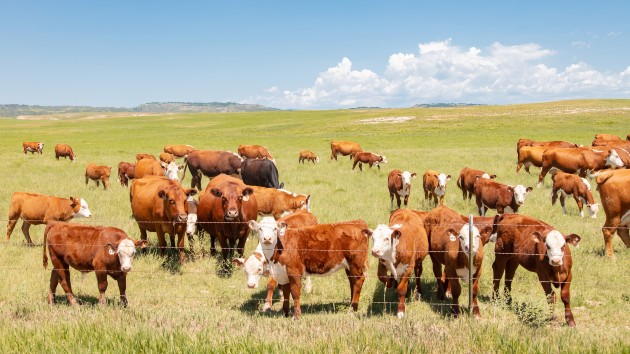USDA conducting studies on beef due to bird flu outbreak but maintain supply is safe

(NEW YORK) — Federal officials continue to investigate the spread of avian flu, also known as bird flu, in livestock across the country and are now testing the U.S. beef supply to look for the genetic presence of the H5N1 virus.
The virus has been found in at least 34 cattle herds across nine states, according to the U.S. Department of Agriculture. The federal agency said it remains confident that the nation’s meat supply is safe.
“There have been no cases of any human being contracting bird flu or H5N1 from meat or milk. So it’s completely safe,” Dr. Scott Haskell, a professor of food safety at the Institute for Food Laws and Regulations at Michigan State University, told ABC News. “It’s not a disease that spreads through eating or drinking.”
A spokesperson from the USDA said in a statement: “USDA has a rigorous meat inspection process, where USDA’s Food Safety and Inspection Service (FSIS) veterinarians are present at all federal livestock slaughter facilities.”
The news from the USDA comes after the Food and Drug Administration noted that fragments of the virus were found in the commercial milk supply. Later tests showed that the widespread practice of pasteurization inactivated the virus.
“This additional testing did not detect any live, infectious virus. These results reaffirm our assessment that the commercial milk supply is safe,” the FDA said.
Experts said people should still be careful of consuming raw milk or products made from raw milk.
“Raw milk is unpasteurized and has a plethora of bacteria and viruses in it … if there is any bird flu in the milk, it’s not going to be denatured or killed. So, you run a minor risk from raw milk,” Haskell explained.
The USDA said it will begin work on three separate beef studies: sampling ground beef at retail stores in states where cattle have tested positive; sampling beef muscle from sick dairy cows that have been culled; and conducting experiments that test cooking ground beef to various temperatures.
“Despite our confidence in the safety of the meat supply, the importance of continued and comprehensive investigations remains critical. These studies are crucial for maintaining public trust and ensuring that our food safety measures evolve in response to new information about H5N1,” said Dr. John Brownstein, chief innovation officer at Boston Children’s Hospital and an ABC News medical contributor.
Only meat that has passed inspection can be sold in grocery stores or restaurants, according to the USDA. The agency has veterinarians that are present at all federal livestock slaughter facilities where animals are inspected before and after slaughter.
Officials continue to recommend safe handling of food to help prevent foodborne illnesses: wash hands and surfaces often, separate raw meats from other foods, cook meat to the right temperature and chill food promptly in a refrigerator. Ground beef should be cooked to 160F and ground poultry to 165F, according to the USDA.
“The USDA’s ongoing studies into the safety of beef considering the H5N1 findings in dairy cattle underscore the thoroughness of our food safety protocols,” Brownstein added.
Copyright © 2024, ABC Audio. All rights reserved.






